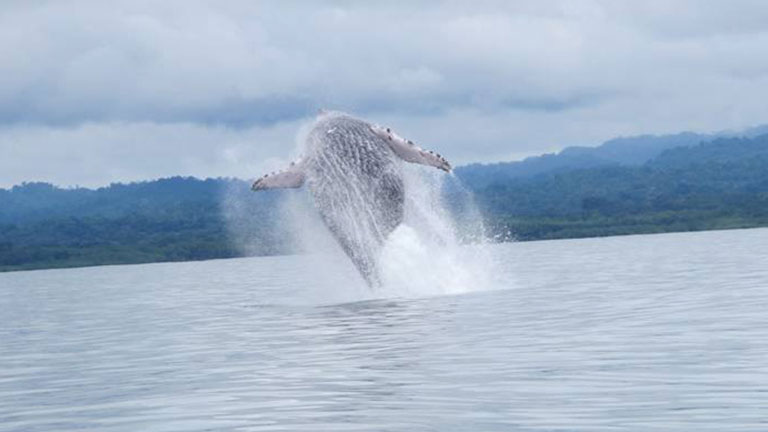The wheres, whys, whens, and whats of Costa Rica´s Whale Watching Season!

Welcome to one of the most exciting seasons of the year in the Golfo Dulce!! How do lots of humpback whales swim the seas just meters from Playa Nicuesa sound? The Ocean´s gentle giants are frolicking in the warm, tropical waters of our favorite Gulf, which is appropriately called Sweet! Nicuesa Rainforest Lodge has front row seats to this nature-rich spectacle so let´s understand the whys, whens, hows, and whats of the Whale Watching Season.
Nicuesa Rainforest Lodge sits on the Golfo Dulce, bordering the Osa Peninsula and the deep-southern coastline. This beautiful body of water was called Sweet Gulf, thanks to its calm, warm waters protected from the open seas. It is also the perfect distance from the Arctic and Antarctica to receive the ocean´s gentle giants yearly. These unique visitors make the Gulf all the sweeter and more exciting.
Where do they come from?
Humpback Whales could well be the world´s most incredible wanderlust beings. They travel thousands of miles between the polar regions' cold waters and the tropics' warmer waters. During their seasonal migration, these magnificent marine animals can travel up to 5000 miles between the high-latitude summer feeding grounds and the winter mating and calving region in warm, tropical waters like Costa Rica and the Gulfo Dulce.
Fun Fact: The Golfo Dulce is the only place on the earth where humpbacks from both the Antarctic and the Arctic come to breed and give birth. They know the right place to go and stay for a while!
The Golfo Dulce is where the Humpback Whales come to visit!
Why do they come?
The Humpback Whales visit the warm waters of the Golfo Dulce and Costa Rica´s Pacific Ocean coastal areas for significant reasons! But, maybe, the most important reason behind their yearly pilgrimage to Costa Rica is to give birth to their calves. So, it is very probable that you will see many mothers and their calves swimming side by side as the Mom shows her baby the art of being a whale.
The warmer water also means that there is plenty to feed upon. So, the whales can consume lots of krill, plankton, and small fish while feeding their calves the nutrient and fat-rich milk they need to grow. In addition, they have a long journey back to the Poles and their cold waters, so the calves need a good layer of fat in preparation for their travels and summer home.
When do they come?
Remember that the warm tropical waters of Costa Rica and its strategic location mean that there are two Humpback Whale Seasons depending on whether they are visiting from the Arctic or the Antarctic. This means that the chances of seeing them in Costa Rica doubles and is yet another reason to visit Costa Rica and Nicuesa Rainforest Lodge!
So, the Southern Humpback Whales can be spotted in Costa Rican waters from late July to early November, with September and October being peak months. The Northern Humpback Whales grace us with their impressive presence from December to late March before heading back to Alaska and beyond.
Those flippers are a sight to see!
What else do they do while at the Golfo Dulce?
Did you know? Humpback songs appear to be shared by all singing members in the same ocean area: as the song changes, all members sing the new song. The male whales are particularly vocal, with long calls during the winter breeding season, seemingly wooing the females. Whatever the reason behind their song, when the different groups interact during the migration or while sharing their summer feeding grounds, they will share their tunes and melodies, which is pretty special.
This means that you may hear the Humpback Whales singing their song during a Whale Watching Tour from Nicuesa Rainforest Lodge. If not, you will more than likely see their very long flippers that can be up to 16 feet (5m) long, which is the largest appendage in the world! In addition, they frequently slap their flippers on the water´s surface, which is always delightful to watch and really works up a splash!
Their tails are pretty impressive too! They grow up to 18 feet (5.5m) wide, which means when you see one, it is a sight to see! The expert naturalist guide on tour is also very talented at spotting whales! So keep your camera and binoculars handy!
The Humpback Whale Watching Season is one of Nicuesa Rainforest Lodge´s favorites. While relaxing in your jungle-chic cabin in the rainforest, walking the trails around the reserve, or enjoying a sunrise or sunset yoga class, knowing that whales are swimming nearby is sweet or dulce! So, which season suits you best to come and see the whales?


